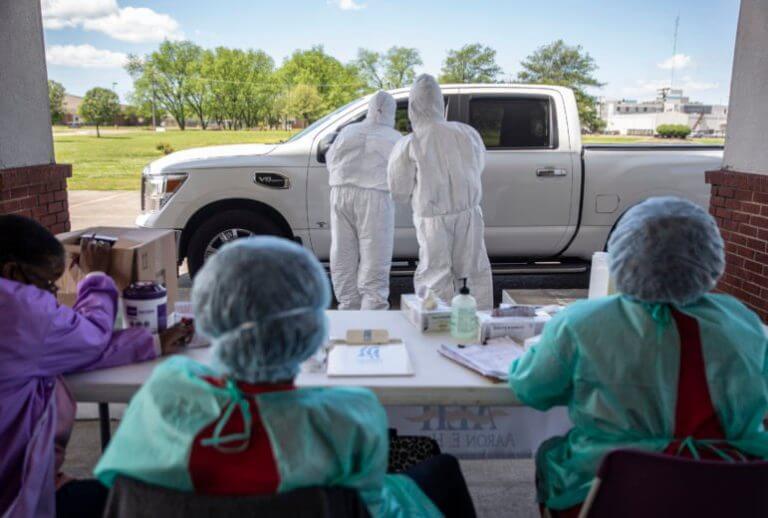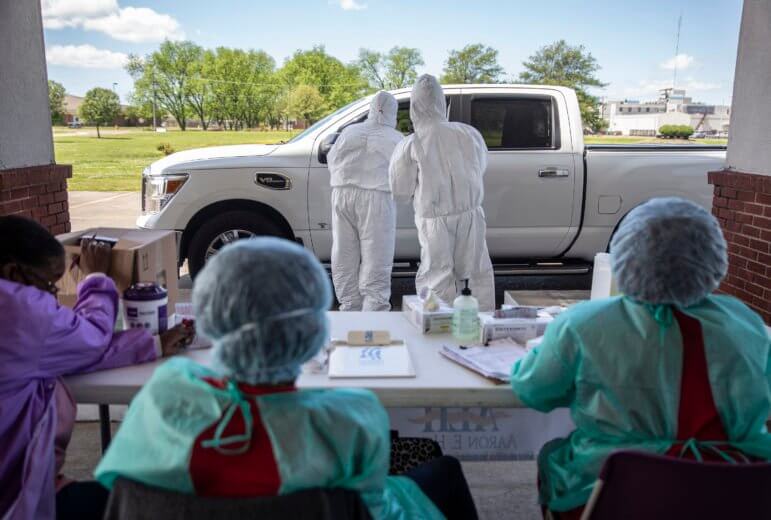

Eric J. Shelton/Mississippi Today
Yvonne Moore, left, and Christy Carmichael collect specimen for COVID-19 testing outside of the Aaron E Henry Community Health Services Center in Clarksdale, Miss., Wednesday, March 29, 2020.
‘Just enough of the right stuff’: Why Mississippi’s COVID-19 numbers are flattening
By Erica Hensley | Sept. 25, 2020
After a steep summer climb in coronavirus cases, Mississippi’s average daily numbers are at the lowest point in three months.
How fast the virus spreads in an area is a function of many things, but they all revolve around behavior and math. Virus transmission boils down to a numbers game — when fewer people have and spread the virus, transmission thins out, helping to flatten the curve over time. The idea of flattening the curve has never been about stopping spread, but reducing that spread over time so health systems are not overwhelmed. Spread is inevitable — it’s limiting and containing transmission that drives infectious disease mitigation strategies.
State Health Officer Thomas Dobbs said Wednesday that statewide efforts to reduce spread since the late July peak are paying off, but new challenges will arise.
“We’re very pleased that we’ve seen this fall trend go so well thus far, knock on wood. The coronavirus I think is a little bit finicky and if you do just enough of the right stuff you can get that R-naught (reproduction) value less than one. And if you get it less than one, then you’re constantly driving it down — it’s just a matter of how fast you’re driving it down,” Dobbs said, adding the “combination of masks, a little bit better social distancing” and strict school policies have slowed the overall spread, though case clusters persist.
“We hope that everybody just keeps up the good work because I think we can continue to keep it down and get through the fall if we just maintain masking and distancing, especially as we go into the holidays, there will be those new challenges,” he said.
A pivotal piece to understanding transmission is the R-naught value that Dobbs referenced, often referred to as just R or the reproduction rate. Three months ago, when Mississippi was entering its summer case surge, the state’s R value was one of the highest in the nation. Now, it’s one of the lowest.
The reproduction rate is just one measure of how the virus is spreading, similar to doubling time. It measures the average number of people infected by each initial infection, representing how much the disease is spreading. If the value is under one, spread is more limited and easier to contain. Above one signifies more uncontrolled spread, meaning infected people are each spreading to more people.
Mississippi’s R hit its lowest point ever exactly two weeks after Gov. Tate Reeves ordered a statewide mask mandate. On August 19 the state’s R dipped to .88 — meaning on average, each person with COVID-19 spread it to less than one person. It has since crept up slightly, but still hovers below one.
Though the state’s number of daily new cases has trended down since late-July, Mississippi still has the third most total cases per capita as of Thursday, at 3,202 per 100,000 people — only behind Louisiana and Florida. The state also has the seventh most total COVID-19 deaths per capita, at 97 per 100,000 people, and the nation’s highest recent death rate, at four per capita over the past week.
R has long been used by infectious disease experts, who say, like all COVID-19 metrics, it’s imperfect, often misunderstood and shouldn’t be used as a guiding star because it misses granular detail, like outbreaks and local spread. If cases are spreading drastically in one area due to a cluster, but tapering off in others where regulations are perhaps more strictly adhered to, the R average could cancel each of those out and paint an imprecise picture. Overall though, it helps gauge how much the virus is spreading across a state.
Importantly, according to those who track and model disease spread, R measures how widespread the virus is, not how fast it’s spreading. Too, R doesn’t calculate why or how infection spreads, such as if people are just more contagious, like a cluster of severe cases, or if their behavior is more risky, like socializing in crowded, indoor areas. That’s where contact tracing comes in.
R is only a piece of the puzzle, and needs to be dovetailed with other disease-tracking pieces to be effective, researchers say. Robust contact tracing, diagnostic and surveillance testing — to catch both active and asymptomatic infections, and spread mitigation efforts, like masks and social distancing, all need to work together to inform policy.
Researchers say R shouldn’t be used as a real-time policy-making tool, but more a lagging indicator — essentially, it can help officials look back at trends to see what worked.
Mississippi has been under a statewide mask mandate since early August, with the current order expiring September 30. Additional mandated restrictions to reduce spread include: Limiting arenas to 25% capacity and prohibiting tailgating, and 75% capacity for retail, restaurants and bars, and bars must close at 11 p.m..
Dobbs says schools’ strict adherence to COVID-19 guidelines have helped mitigate spread, and in turn kept new cases and the R value down. But outbreaks persist and threaten to reverse downward trends where folks continue to gather without masking and distancing, he said.
To date, schools have seen 2,400 cases total, with 382 new cases over the last week. Though statewide trends have improved, younger age groups still comprise a disproportionate share of all cases.
Dobbs says most schools have policies in place that are limiting spread once it is brought in. He praised universities for planning for and curbing the virus, though they have seen recent spikes and have varying approaches to containing spread.
“It’s social stuff that’s killing us as far as when we were having outbreaks. It’s parties, and it’s even small gatherings of people getting together,” he said. “If we look at schools settings, where we’re seeing most of our outbreaks and transmission, it’s not really going to be in these controlled structured settings within the classrooms, it seems mostly to be in athletics or extracurriculars where we know there’s going to be more chaotic movement and less control as far as where kids are and (are not) wearing the masks.”
Visit our data page for more Mississippi COVID-19 trends and school trends here.
The post ‘Just enough of the right stuff’: Why Mississippi’s COVID-19 numbers are flattening appeared first on Mississippi Today.
- Wild hogs wreak economic havoc in Mississippi - December 24, 2025
- For Delta transplant, personal journey and Onward Store revival are aligned - December 24, 2025
- Hosemann urges fellow Republicans on election board to fight judicial redistricting order - December 23, 2025